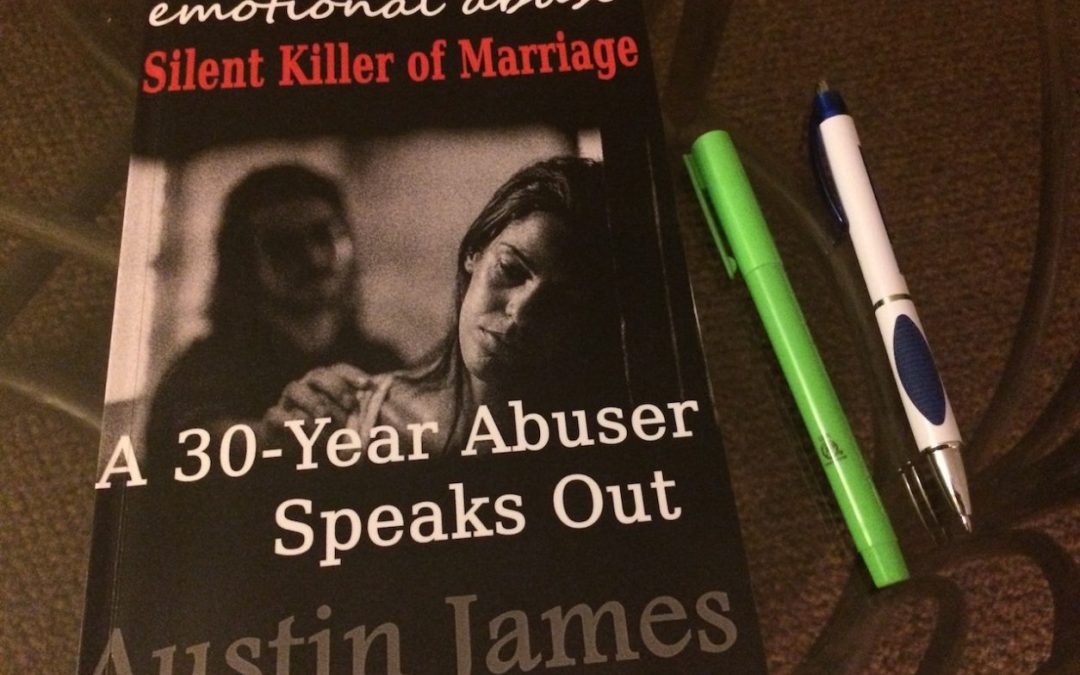I’m always happy to discover books that might help readers to stop hurting the ones they love. I’m especially excited when someone who has done harm but has successfully changed writes the book. That’s why I was anxious to order and read the self-published book, “Emotional Abuse: Silent Killer of Marriage” by Austin James. Would he share similar experiences and helpful remedies as those we talk about in our material, or would he have a very different perspective?
While Mr. James writes about emotional abuse and not specifically physical abuse, the experiences he had and the concepts he shares are absolutely applicable to both. Here are several of the similarities:
- He describes the changes in his life as “the most incredible journey” and complete transformation. We hear and use those words a lot, too.
- For Austin, the catalyst for his change only happened after his wife told him that she wanted a divorce. Unfortunately for many of us, that kind of rock-bottom experience is necessary for us to understand the need to change and to get the motivation. It certainly was for me.
- Mr. James describes many ways that he used various forms of controlling behavior, which serves as a good emotional abuse checklist for any of us who may still be wondering if we have crossed that line. You’ll see a lot of overlap with our list, “What is emotional abuse?”
- In the beginning, he thought his issue was just a character flaw that he had difficulty controlling anger. He believed he’d benefit from anger management counseling. What he learned, however, is that there was a deeper issue that needed healing before he would find peace. Many of us who have done harm in our relationships start with anger because it is directly connected to the harm, but end up learning that healing the root cause of our anger is also healing what causes abuse and domestic violence.
- Throughout the book, the author describes the change process as a series of discoveries that led to growth and change, but also discusses setbacks and relapses. These are common. As he urges, don’t let them discourage you from continuing your work.
- He does a good job connecting his life story to the emotional wounds he carried and how those played out in his abusive behavior. Each of us has a different life story and a slightly different set of wounds that can express themselves in abusive and violent behavior. What we have in common, however, is that the process of discovering and healing those wounds is the key to stopping domestic violence and domestic abuse.
- Austin talks about working in an abusive environment after his transformation and how that proved to be a good test of his growth. The ability to respond constructively rather than react and match the abuse directed toward us is a great sign of progress.
- I really liked what he says about the two things needed to break free of abusive patterns: awareness and a teachable attitude. Awareness begins with understanding what is abuse. Of course, awareness is not enough unless we are motived to change. There are plenty of reasons to desire change, but especially knowing how it hurts others as well as us is one of the biggest.
- Mr. James offers several tips for getting started on the change process, including taking full responsibility for what we’ve done, focusing on ourselves rather than our partner, and being patient with ourselves. It’s great advice.
- He discusses triggers, the concept of time tunneling (although he does not use that particular term), and how the brain is wired to react very quickly to perceived threats. His understanding is consistent with our discussion on brain anatomy.
- The author urges anyone embarking on this journey to get professional counseling help. We agree, if it is at all possible to do so. He also shares his perspective on what to look for in selecting an appropriate counselor.
- He discusses why couples counseling is not appropriate in cases of abuse—because we need to heal ourselves first before we can work constructively to heal a damaged relationship. It is a truth well-said.
- I was particularly pleased to see him talk about the value of journaling. It was great validation of something we think makes a big difference in your progress.
- He discusses the rules and value of time-outs, which aligns pretty well with what we share on our website.
- Austin gives some guidelines that can help either the person who is doing harm or the one who has been harmed to measure progress. His advice is spot on.
- Finally, he gives the credit for his radical change to a relationship with Jesus Christ. He shares that he has personally met and talked to nine individuals who are recovering abusers. Every one of them testifies about the importance of this relationship. We, too, believe developing a relationship with Christ is the most effective way to heal the hurts that cause abuse and to bring about the change that you are seeking.
While “Emotional Abuse: Silent Killer of Marriage” and the Ananias Foundation are sharing much of the same information, we all connect differently with different writing styles and different perspectives. Austin James’s book reads with an authentic voice, just as if he was sitting at our kitchen table telling us his story. We can’t have too many people pointing to the truth about how to stop abuse, so if this book helps anyone recognize the harm they are doing or is useful in their change, then it has served its purpose.


Recent Comments